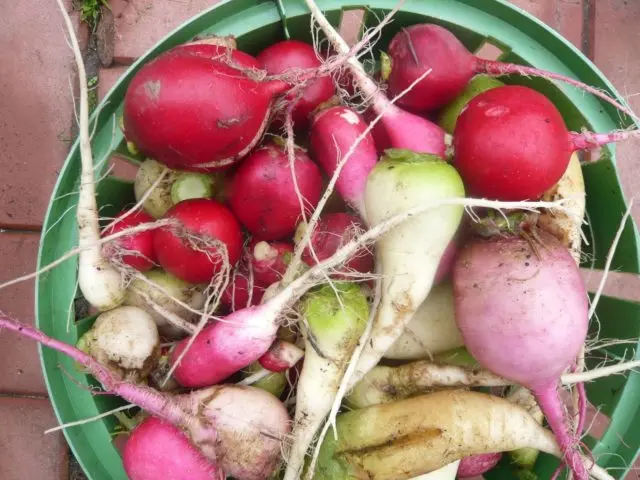Contents
Radishes under the film are planted to obtain an early harvest of the root crop. To properly grow radishes in early spring, you need to know about some planting rules and the nuances of caring for this vegetable crop.
Rules for growing radishes under a film
Early sowing of radishes under the film involves the use of early ripening varieties that are resistant to temperature extremes, sudden cold snaps, and also not prone to the appearance of arrows.
How to choose the right variety
It is no secret for every vegetable grower that there are various varieties of radish on the market, among which there are the most promising specimens. These include:
- Ice icicle;

- That;

- Goddess;

- Pharaoh;

- Ice icicle;
- Sora;
-

- early red;

- Carmen;

- Glowworm;

- Dawn;

- Prime minister;

- French breakfast;

- White Nights.

Each variety of radish selected for planting under the film has its own characteristics. This applies to the shape: it can be elongated, oval, round, and also have colors from pink and white to deep purple. On average, the weight of root crops ranges from 7 to 25 g.
Advantages of this method
Planting early radishes under a film is an opportunity to get fresh root crops already in early to mid-April. Seeds are planted on the 20th of March, and the vegetable crop ripens 2 weeks earlier than the specimens planted in the greenhouse.
Radish seeds germinate even at a temperature of 2 degrees Celsius, young shoots are not afraid of night temperature drops. But the main condition is that the radish loves the light. Without enough sunlight, the seeds will germinate worse, which will increase the ripening period of root crops.
How to plant a radish under a film
Any summer resident, even a beginner, can grow radishes under a film. The main thing is to monitor the air temperature and the number of hours of sunshine per day.
When can you plant radishes under the film
Planting radishes under the film can be carried out as early as March. Experienced gardeners recommend not to wait for the snow to completely thaw. It is enough for the snow to come off the soil in a certain area, and thawed patches appear. Seeds require only a 3-centimeter layer of thawed soil. This is quite enough for the radish to begin its growth.
If you plant radish under a film in April, then you will need to take care of its shelter from prolonged exposure to sunlight. For this culture, light is extremely important, but its excess can lead to its shooting. Therefore, the best option is considered to be daylight hours lasting 8 – 10 hours.
Site selection and preparation of soil
Many varieties of radishes do well in soil with medium fertility. But a variety like French Breakfast is very demanding on the soil. He needs a fertile light substrate. In any case, it is best to prepare the soil so that young vegetables have enough nutrients to develop.
If a place for radishes was allocated in the fall, then fertilization also needs to be taken care of during this period. The application of mineral fertilizers and mulching is considered optimal.
In the place of the future planting of the vegetable, it is necessary to lay a small layer of humus, cover everything with a film or boards. In the spring, when the snow begins to melt, the flooring is removed so that all vital substances enter the soil along with melt water. However, when sowing radish seeds under the film, excess humus must be removed.
Sowing radishes in the spring under the film
Radish seeds do not need pre-germination. Therefore, sowing is done immediately in the beds. For those who wish to speed up the germination of crops, it is recommended to soak the seeds a few days before planting. You can do this in any of the convenient ways.
Seeding algorithm:
- First you need to make several grooves with a depth of 3 – 5 cm (which is optimal for sowing a vegetable crop) and an interval of 15 cm.
- Each groove must be shed with warm water.
- Seeds (if possible) should be sown at a distance of 5 cm from each other. Since they are quite small, it is worth purchasing a spot seeder in advance or sowing with a special tape. Otherwise, the grown radish will have to be pulled apart.
- Seeds in the grooves should be sprinkled with a small layer of loose earth.
- After pouring a small amount of water.
- Sowing cover with a film and fix it around the perimeter.

How to grow early radishes under a film (write all the rules of care)
A distinctive feature of growing radish under a film is the fact that it is practically not required to care for it. When creating a greenhouse effect, a sufficient amount of moisture is retained in the soil, so even watering is carried out as the soil dries up.
It is important to follow a few basic rules for caring for early radishes planted under a film:
- Application of fertilizers. Every 10 days it is necessary to feed the radish with urea diluted in water (10 g per bucket). Once (about 15 days after sowing), you can apply any potash fertilizer.
- Watering. It is carried out as the soil dries out. It is not worth pouring early radishes, especially at the end of ripening, as this will lead to cracking of the fruit.
- Loosening. If necessary, loosen the soil using small tools (garden shovels or miniature rakes). Loosening with a chopper is not worth it – you can damage the root crop.
- After sowing, it is necessary to cover the radishes for the night, especially during frosts. This can be done with any suitable material.
- With an excess of sunlight, the bed is covered with dark material. For radishes, 8 hours of daylight will be enough. If this condition is not met, then the culture will begin to shoot.
- Weed control is not required.
Pests and diseases
Radishes planted under film can also suffer from various pests, like vegetables planted in open ground. The only difference is that for early ripening varieties of vegetables, the use of chemicals designed to fight pests is not recommended. Therefore, many summer residents prefer to do with folk methods.
The main enemy of the early radish is the cruciferous flea. To get rid of it, you will have to get tobacco dust or fresh ash. These are the only remedies that have the desired effect on the flea, even with a large-scale damage to the plant. The parasite appears during dry periods, since fleas cannot “perforate” wet foliage. To combat this pest, you must:
- Dilute the ash solution by mixing water (10 l) with a glass of fresh wood ash.
- Water the radish, getting on the young tops.
- If necessary, sprinkle the beds with undiluted ash or tobacco ash.

Another dangerous pest is the blind man. Garlic tincture will help protect against it:
- A large head of garlic must be crushed.
- Pour in a liter of boiling water.
- Insist during the day.
- Bring the solution to 5 liters, diluting with warm water.
- Spill the radish.
- If necessary, repeat the procedure after 5-7 days.
Medvedka attacks radishes only when there is a complete drought in the garden, and the garden with radishes remains wet. It is not always possible to fight this parasite with folk methods, so many summer residents go to the trick – they bury potato tubers in another part of the garden and water the beds abundantly using some kind of poison for the bear. Since the insect usually looks for the most humid places in which to eat, the radish can be considered saved.
The diseases that radish is susceptible to include mucous bacteriosis, phomosis, fusarium, dry rot, common mosaic, rot, powdery mildew, black leg.
If the use of chemicals is not intended, a soap solution can be prepared that fights these pathologies well. Necessary:
- Grate 100 g of laundry soap.
- Take a bucket of water (10 l).
- Pour 500 g of fresh ash into the water.
- Add soap.
- Stir well.
- Water the plant with the resulting solution.
What problems can arise
Some gardeners may encounter a number of problems when growing radishes under film. Among them are the following:
Problem | Cause | Solution |
Poor seed germination | · Deep landing. · Poorly heated soil. Deficiency of nutrients. | Radishes planted deep or in too cold soil will not die, but will “sit” in the ground until more favorable conditions come. With a lack of nutrients, the problem is solved by introducing suitable dressings (potassium-containing preparations). |
Arming | Excessive exposure to sunlight. | If the radish was planted during a period when the sunny day exceeds 10 hours, the culture must be covered from the light. This can be done with any suitable material. |
Crackling fruity | Waterlogging of the soil in the last stage of maturation. | If the radish is often watered, then its fruits will absorb moisture, like a sponge. As a result, not only the appearance of the root crop will suffer, but also its taste. |
Conclusion
Radishes under the film can be planted in early spring. This will allow not only to enjoy the first vitamin vegetables, but also to prepare the ground for planting any other crops. After all, after radishes, the soil becomes better and is suitable for growing the most capricious vegetables.




















